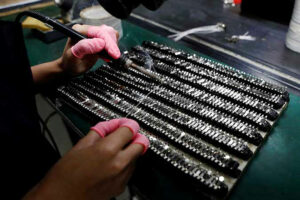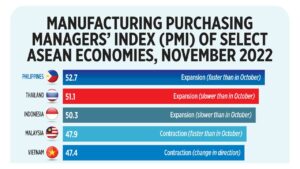Factory output growth slowest in over a year

By Luisa Maria Jacinta C. Jocson, Reporter
FACTORY PRODUCTION grew at its slowest pace in over a year in October as elevated inflation may have dampened demand.
Preliminary results of the Monthly Integrated Survey of Selected Industries (MISSI) released by the Philippine Statistics Authority (PSA) showed manufacturing output, measured by the volume of production index (VoPI), inched up by 1.7% year on year in October.
This was slower than the 6.7% annual increase in October 2022 and the 9.9% logged in September.
October marked manufacturing’s weakest growth since the 0.04% decline in June 2022.
On a month-on-month seasonally adjusted basis, the manufacturing sector’s VoPI contracted by 4.1%, a reversal of the 1.5% growth in the previous month.
Year to date, average factory output growth stood at 5.6%, much slower than 17.5% in the same period in 2022.
Rizal Commercial Banking Corp. Chief Economist Michael L. Ricafort also said the softer manufacturing production reflected the impact of elevated inflation, which pushed input costs higher.
Headline inflation eased to 4.9% in October from 6.1% in September and 7.7% in October 2022. However, this marked the 19th straight month that inflation breached the central bank’s 2-4% target band.
“Slower factory output growth may stem from lower demand from manufactured goods due to low purchasing power of consumers despite slowing inflation seen in October,” John Paolo R. Rivera, president and chief economist at Oikonomia Advisory & Research, Inc., said in a Viber message.
Mr. Rivera said the slower increase in factory production can also be attributed to delays in the delivery of raw materials amid “constraints in international trade brought about by conflicts in major trade routes in Europe and the Middle East.”
High interest rates may have also affected manufacturing firms’ operations.
“Manufacturing also partly weighed by higher local interest rates that increased borrowing and financing costs of manufacturers, thereby reducing new investments and expansion projects,” Mr. Ricafort said.
The Bangko Sentral ng Pilipinas (BSP) has raised borrowing costs by a cumulative 450 basis points (bps), bringing the benchmark rate to a 16-year high of 6.5%.
PSA data showed the slower annual growth of the VoPI in October was mainly due to the 33.9% contraction in beverages from the 13% growth in September, and the 1.9% decline in computer, electronic and optical products from the 4.2% growth in September.
Coke and refined petroleum products increased at a slower pace of 46.8% in October from 78.5% in the prior month.
The PSA said that 13 industry divisions recorded annual declines during the month. This was led by wood, bamboo, cane, rattan, articles and related products (-41.8% from -8.7%), tobacco products (-18% from -6.6%), chemical and chemical products (-10.1% from -8.1%), other manufacturing and repair and installation of machinery and equipment (-7.9% from -3.1%) and textiles (-7.7% from -3%).
On the other hand, industry divisions that showed faster annual increases included electrical equipment (32.1% from 28%), printing and reproduction of recorded media (26.3% from 16.6%) and basic metals (19.9% from 18.6%).
PSA data showed the capacity utilization rate in October averaged 74.3%, a tad lower than 74.4% in the month earlier. All industry divisions also exceeded 50% utilization during the month.
“The top three industry divisions in terms of reported capacity utilization rate were manufacture of machinery and equipment except electrical (83.3%), manufacture of rubber and plastic products (81.2%), and manufacture of tobacco products (80.5%),” the PSA added.
For the coming months, Mr. Ricafort said that easing global oil prices would help tame inflation.
“(This) would reduce input costs of manufacturers and would also support a pause and possibly cuts in Fed and local policy rates by 2024, thereby would reduce borrowing/financing costs that would support continued pickup/recovery in the local manufacturing sector,” he added.




